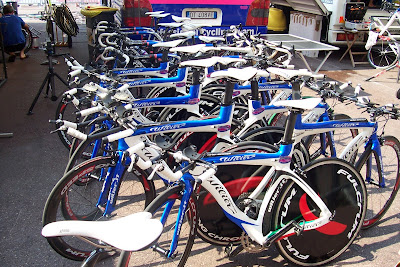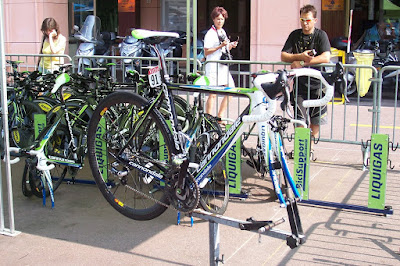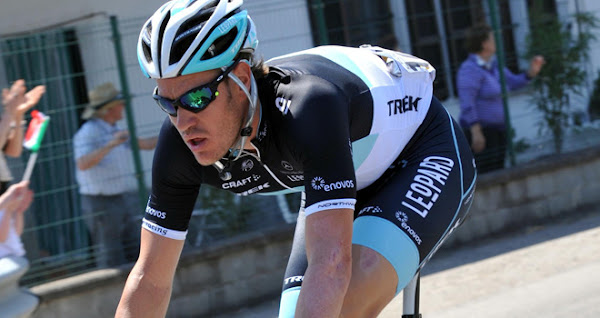This evening sees the commencement of my annual three weeks of staying up late to watch the highlights of the days Tour de France stage.
The race actually starts tomorrow but, British Eurosport being the Damn Good Eggs that they are, are showing a Mark Cavendish special plus two previews, one about the main contenders for the race and the other being the official introduction of the teams.
Seeing as how Cav is the Official Pro Cyclist of The Secret Cyclist blog (not that he knows, but I know), it would be very remiss of me not to watch him wouldn’t it? The other two programmes are proper fan fodder and I will watch them cos it is cycling on the tellybox, which is A Good Thing.
A Layman’s (or Laywoman’s) guide to the Tour de France (TdF) Part 1The TdF starts on the first Saturday in July each year and finishes on the Sunday, 3 weeks later. This entails 21 days racing with 2 rest days. This year, the rest days are between stages 9 and 10 and stages 15 and 16.
Most years, the first day is a prologue, a short Time Trial stage of 5 to 10 kilometres. This year however, stage 1 is a full on mass start stage of 191.5 kilometres.
There are 4 types of stage in the Tour. Time Trail (TT) stages, ‘flat stages’, medium mountain stages and high mountain stages.
For TT stages each rider sets off individually at timed intervals. Stage lengths are between 20 to 50 kilometres roughly and it is literally a race against the clock. There is another TT type, called the Team Time Trial (TTT) where each team sets off together and rides as fast as it can over the course. The Teams time is taken as the 5th rider crosses the line. If all 9 members of the team finish together, they get the time of the 5th rider. If the team splits, the first 5 riders get the time of the 5th rider. The remaining riders get their own actual time.
 Team Lampre's TT bikes at Monaco the day before the prologue for the TdF 2009
Team Lampre's TT bikes at Monaco the day before the prologue for the TdF 2009 Cav on the prologue in Monaco for the TdF 2009
Cav on the prologue in Monaco for the TdF 2009
Flat stages are pretty much just that, flat of lightly rolling roads with no climbs of note. These tend to be targeted by sprinters for stage wins.
 A team Liquigas Cannondale being prepared for Stage 1 of the 2009 TdF (Mrs Secret Cyclist in the background)
A team Liquigas Cannondale being prepared for Stage 1 of the 2009 TdF (Mrs Secret Cyclist in the background)Medium mountain stages involve more strenuous climbing but not the really hard mountains.
High mountains are just that, lung busting, leg killing mountain passes and summit finishes.
There are 5 separate competitions within the race as follows-
The General Classification (GC). The leader in the GC is the leader of the race overall. He is identified by the fabled Yellow Jersey (Maillot Jaune). This is the rider with the smallest aggregate time for the race at the start of each stage. Contenders for the ultimate prize need to be very good all round riders. In recent years, contenders have been strong climbers with good time trialling ability.
The Points Competition, often called the Sprinters competition. The leader in this competition is identified as he wears the Green Jersey (Maillot Vert). Each road stage includes one or two intermediate sprints. Points are awarded in descending order to the first three riders across the line- 6, 4 then 2 points. The same happens at the end of stages also but, a stage winner can gain up to 35 points on a flat stage, with the first 25 riders earning points down to 1 point. On Medium Mountain stages it is the first 20 riders with the points range between 25 and 1. On High Mountain stages the first 15 riders earn between 15 and 1 point. TT stages also have points, ranging between 15 and 1 for the first 10 riders.
The winner of the point’s competition is the rider with most points who finishes the Tour
King of the Mountains (KoM) who is identified by the Polka Dot jersey (Maillot a pois rouges). This is a white jersey with red polka dots. This competition is another point’s competition, where the points are earned by being in the first number of riders to cross the line on climbs. The climbs in the TdF fall into 5 different categories, depending on their length, gradient and where they occur in a stage.
The easiest climbs are 4th category climbs with 3, 2 and 1 points being awarded to the first 3 across the line.
Next is 3rd cat climbs with between 4 and 1 points awarded to the first 4 riders.
2nd cat climbs have the first 6 riders earning between 10 and 5 points.
1st cat climbs earn the first 8 riders between 15 and 5 points.
That leaves climbs that are beyond classification or Hors Categorie (HC). These are the steepest, longest and hardest climbs in the Tour. The first 10 riders on HC climbs earn between 20 and 5 points.
The winner of the KoM completion is the rider with most climbing points who finishes the Tour.
Best Young Rider who is identified by the White Jersey (Maillot Blanc). This competition is amongst all riders under 26 years of age as of 1st January that year. The leader in the competition is the qualifying rider highest up the GC competition.
The Team Competition is similar to the GC but is worked out using the time of the best three riders of each team, each day. The team leading this competition is identified by the numbers on their jerseys being black numbers on a yellow background as opposed to the standard black on white.
It is common for the same rider to lead several competitions. In the event this is the case, he wears the jersey of the higher competition so, a rider leading the points and GC competition would wear the yellow jersey. The rider second in the lower competition then wears the competition jersey. As a result, not every rider you see wearing a competition jersey is actually the leader (apart from the GC jersey).
Not a competition but, seen by many fans of the race as a badge of honour, is the Lantern Rouge or red Lantern. This is the rider last in the overall classification- the rider who has taken the longest time so far. In early years, the Lantern Rouge was just that, a small red light on the back of that rider’s bike. I think (though am not certain at the moment) that the Lantern Rouge wears red numbers on a white background.
More later.





